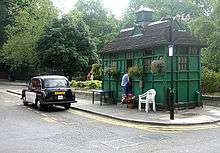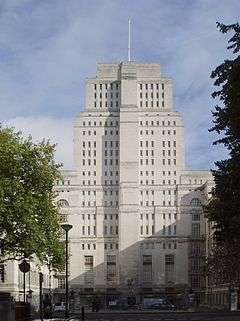Russell Square

Russell Square is a large garden square in Bloomsbury, in the London Borough of Camden, built predominantly by James Burton. It is near the University of London's main buildings and the British Museum. To the north is Woburn Place and to the south-east is Southampton Row. Russell Square tube station is nearby to the north-east.
It is named after the surname of the Earls and Dukes of Bedford; the freehold remains with the Bedford Estate, though the square is managed by Camden Council.
History

The square is named after the surname of the Earls and Dukes of Bedford, who developed the family's London landholdings in the 17th and 18th centuries, beginning with Covent Garden (Bedford Street). Russell Square was formed when new streets were laid out by the 5th Duke on the site of the gardens of his former home Bedford House, their London house. Other local street names relating to the Duke of Bedford include Bedford Square, Bedford Place, Bedford Avenue, Bedford Row and Bedford Way; Woburn Square and Woburn Place (from Woburn Abbey); Tavistock Square, Tavistock Place and Tavistock Street (Marquess of Tavistock), and Thornhaugh Street (after a subsidiary title Baron of Thornhaugh). The street lamps around this area carry the Bedford Arms.
The square contained large terraced houses aimed mainly at upper-middle-class families. A number of the original houses survive, especially on the southern and western sides. Those to the west are occupied by the University of London, and there is a blue plaque on one at the north west corner commemorating the fact that T. S. Eliot worked there for many years when he was poetry editor of Faber & Faber: a building now used by the School of Oriental and African Studies (a college of the University of London). Thomas Lawrence had a studio at number 65 (1805–1830). On the eastern side the Hotel Russell, built in 1898 to a design by Charles Fitzroy Doll, dominates (its builders were connected with the company which created RMS Titanic), alongside the Imperial Hotel, London, built in 1966. Other past residents include the famous 19th Century architectural partnership of father and son, Philip and Philip Charles Hardwick who lived at number 60. Since 2004, the two buildings on the southern side, at numbers 46 and 47, have been occupied by the Huron University USA in London (now the London campus for EF International Language Centres and is the Centre for Professional Students over the age of 25).
In 1998, the London Mathematical Society moved from rooms in Burlington House to De Morgan House, at 57–58 Russell Square, in order to accommodate staff expansion. A near neighbour, at 52-53 Russell Square, is the Chartered Institute of Public Relations, which moved there in 2009.


In 2002, the square was re-landscaped in a style based on the original early 19th-century layout by Humphry Repton (1752–1818). In addition, the café in the square was redeveloped and a new ornamental fountain installed. Although it is managed by the London Borough of Camden, the freehold of the square remains with the Bedford Estate.
On 7 July 2005, two terrorist bombings occurred near the square. The square was also the site of a mass stabbing in 2016.
Cabman's shelter

The Cabmen's Shelter Fund was established in London in 1875 to run shelters for the drivers of hansom cabs and later hackney carriages (and taxicabs).[2]
The Russell Square shelter is one of thirteen such shelters that still exist. All are now Grade II listed buildings.
Commemoration of July 2005 bombings

One of the bombings of 7 July 2005 was on a London Underground train from King's Cross St Pancras tube station to Russell Square tube station, and another was on a bus on Tavistock Square, near Russell Square. To commemorate the victims, many flowers were laid at a spot on Russell Square just south of the café. The location is now marked by a memorial plaque and a young oak tree.
Literature and culture
- In the early chapters of Thackeray's Vanity Fair (1848), set c. 1812, Russell Square is evoked as the residence of the "John Sedley, Esquire, of Russell Square, and the Stock Exchange."[3]
- 21 Russell Square is the murderer's street address in the novel (but not in the movie adaptation) The Murderer Lives at Number 21 (L'Assassin habite au 21) by the Belgian writer Stanislas-André Steeman.
- In John Dickson Carr's detective novel The Hollow Man, the victim, Professor Grimaud, lives in a house on the western side of Russell Square.
- In Alan Hollinghurst's novel "The Swimming Pool Library" (1988) the protagonist William Beckwith spends time here with his lover who works in a hotel overlooking the square.
- In Chapter 6 - Rendezvous of John Wyndham's novel "The Day of the Triffids" (1951) The main characters William (Bill) Masen and Josella Playton are photographed by Elspeth Cary in Russell Square while practicing with Triffid Guns.
- Russell Square is the location of the eponymous bookshop in the Channel 4 sitcom Black Books.
- In book 7; Enemies by Robert J. Crane, the main character Sienna often mentions Russell Square and its surrounding areas as she runs for her life.
- In Ben Aaronovitch’s Peter Grant books, the first of which is The Rivers of London (AKA Midnight Riot), The Folly – headquarters of British wizardry – is located in Russell Square.
See also
| Wikimedia Commons has media related to Russell Square. |
- List of eponymous roads in London
- Other squares of the Bedford Estate in Bloomsbury included:
References
- ↑ "The Square Occupied Social Centre"
- ↑ "Cabman's shelters, London - Victorian survivors on London's streets", Urban75, April 2006
- ↑ William Makepeace Thackeray, Vanity Fair, Ch. 4.
Coordinates: 51°31′18″N 0°7′34″W / 51.52167°N 0.12611°W

